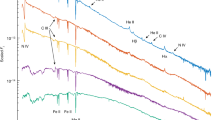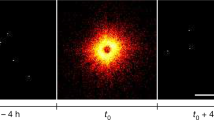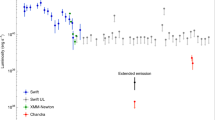Abstract
Long-slit spectroscopic CCD observations of the H II region N44C (refs 1–3) in the Large Magellanic Cloud and its central hot, massive star2,3 show that the stellar temperature is far too low to account for the high excitation of the nebula. In particular the strong nebular HeII 4686-Å recombination radiation, which is absent in normal H II regions, cannot be understood in terms of ionization by the stellar ultraviolet flux. Here we propose an alternative interpretation in terms of a (fossil) X-ray photo-ionized nebula resembling the recently discovered He III region around the luminous X-ray binary LMC X-l (ref. 4). In this picture the presently extinct X-ray source that has been responsible for the high ionization in N44C could well be identical with the transient LMC X-5 (refs 5, 6). From photon-counting arguments and re-combination timescales of the interstellar plasma we find that less than 100 years ago the X-ray luminosity should have been compar-able with that of the most luminous X-ray binaries (a few x l038erg s−1). This hypothesis can be tested by future observa-tions.
This is a preview of subscription content, access via your institution
Access options
Subscribe to this journal
Receive 51 print issues and online access
$199.00 per year
only $3.90 per issue
Buy this article
- Purchase on Springer Link
- Instant access to full article PDF
Prices may be subject to local taxes which are calculated during checkout
Similar content being viewed by others
References
Aller, L. H., Czyzak, S. H., Keyes, C. D. & Boeshaar, G. Proc. natn. Acad. Sci. U.S.A. 71, 4496–4499 (1974).
Elliott, K. H., Goudis, C., Meaburn, J. & Pilkington, J. Astrophys. Space Sci. 55, 475–486 (1978).
Stasinska, G., Tester, G. & Heydari-Malayeri, M. Astr. Astrophys. 170, L4–L6 (1986).
Pakull, M. W. & Angebault, L. P. Nature 322, 511–517 (1986).
Markert, T. H. & Clark, G. W. Astrophys. J. 196, L55–L58 (1975).
Griffiths, R. C. & Seward, F. D. Mon. Not. R. astr. Soc. 180, 75–79.
Husfeld, D., Kudritzki, R. P., Simon, K. P. & Clegg, R. E. S. Astr. Astrophys. 134, 139–146 (1984).
Stasinska, G. Astr. Astrophys. Suppl. 48, 299–304 (1982).
Kudritzki, R. P. Astr. Astrophys. 85, 174–183 (1980).
Simon, K. P., Jonas, G., Kudritzki, R. P. & Rahe, J. Astr. Astrophys. 125, 34–44 (1983).
Chiosi, C. & Maeder, A. A. Rev. Astr. Astrophys. 24, 329–375 (1986).
Prantzos, N., Doom, C., Arnould, M. & de Loore, C. Astrophys. J. 304, 695–712 (1986).
Maeder, A. & Meynet, G. Astr. Astrophys. 182, 243–263 (1987).
Pylyser, E. Doom, C. & de Loore, C. Astr. Astrophys. 148, 379–385 (1985).
Abbott, D. C. & Conti, P. S. A. Rev. Astr. Astrophys. 25, 113–150 (1987).
Conti, P. S. & Frost, S. A. Astrophys. J. 212, 728–742 (1977).
Gabler, R., Gabler, A., Kudritzki, R. P., Puls, J. & Pauldrach, A. Astr. Astrophys. (in the press).
Shull, J. M. & McKee, C. F. Astrophys. J. 227, 131–149 (1979).
Long, K. S., Helfand, D. J. & Grabelsky, D. A. Astrophys. J. 248, 925–944 (1981).
Byrne, P. B. Nature 257, 110 (1975).
Aldrovandi, S. M. V. & Pequinot, D. Astr. Astrophys. 25, 137–140 (1973).
Gould, R. J. Astrophys. J. 219, 250–261 (1978).
Spitzer, L. Physical Processes in the Interstellar Medium (Wiley, New York, 1978).
Harrington, I. P. & Maronni, P. A. Astrophys. J. 206, 458–468 (1976).
Binette, L. & Robinson, A. Astr. Astrophys. 177, 11–21 (1987).
Tuohy, I. R. & Dopita, M. A. Astrophys. J. 268, L11–L15 (1983).
Dopita, M. A., Meatheringham, S. J., Nulsen, P. & Wood, P. R. Astrophys. J. 322, L85–L89(1987).
Savonije, G. J. in Accretion Driven X-ray Sources (eds Lewin, W. H. G. & van den Heuvel, E. P. J.) 343–366 (Cambridge Univ. Press, 1983).
Jones, C. A., Foreman, W. & Liller, W. Astrophys. J. 182, L109–L112 (1973).
Pietsch, W., Steinle, H., Gottwald, M. & Graser, U. Astr. Astrophys. 157, 23–28 (1986).
Van Paradijis, J. in Accretion Driven X-ray Sources (eds Lewin, W.H.G. & van den Heuvel, E. P. J.) 189–260 (Cambridge Univ. Press, 1983).
Johnson, H. M. Astrophys. J. 198, 111–118 (1975).
Author information
Authors and Affiliations
Rights and permissions
About this article
Cite this article
Pakull, M., Motch, C. Is N44C a fossil X-ray ionized nebula?. Nature 337, 337–339 (1989). https://doi.org/10.1038/337337a0
Received:
Accepted:
Issue Date:
DOI: https://doi.org/10.1038/337337a0
Comments
By submitting a comment you agree to abide by our Terms and Community Guidelines. If you find something abusive or that does not comply with our terms or guidelines please flag it as inappropriate.



